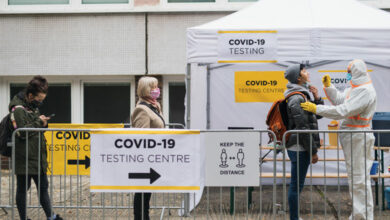All Ireland life and health comparison: Seven less years of healthy life

People in Northern Ireland can expect at least seven less years of healthy life, to be more reliant on family and friends for childcare, and are less likely to be employed than their southern counterparts, a spate of recent publications highlight.
The Department of Health’s most recent publication of figures for life expectancy and healthy life expectancy, published in January 2023, covered the period 2019-2021 and found life expectancy in Northern Ireland to be 78.4 years for males and 82.2 years for females, but also found healthy life expectancy to be 60.6 years for males and 62.7 years for females. In data published by the Central Statistics Office (CSO) in 2022, life expectancy in the Republic of Ireland was found to be 79.6 years for males and 83.4 years for females in 2016; healthy life expectancy stood at 68.4 years for males and 70.4 for females. These figures mean that the smallest healthy life expectancy gap between the north and south was between northern females and southern males, 5.7 years. The gap stood at over seven years for both sexes when compared to their southern counterparts.
A March 2022 comparison of the two primary care systems in the Republic and Northern Ireland by the Economic and Social Research Institute (ESRI) found that “one system does not consistently do better than the other” but that the Republic has performed better in terms of infant mortality and life expectancy, and that there were higher levels of unmet healthcare needs due to affordability in the Republic. However, the most common reason for unmet healthcare needs in both jurisdictions is long waiting lists, and while both have experienced increases in this regard, the increase has been much more pronounced in Northern Ireland. From 2017 to 2021, the proportion of patients on day and in-patient waiting lists for more than one year rose from 20 per cent to 60 per cent in Northern Ireland, compared to a rise from 12 per cent to 20 per cent in the Republic.
Education and childcare
Further ESRI research, published in 2023 in the Irish Studies in International Affairs journal, found educational attainment in 2019 to be higher in the Republic of Ireland than in Northern Ireland. The proportion of those aged 15-64 with a lower secondary level of education stood at 24 per cent as compared to 21 per cent in the Republic. In terms of higher educational attainment – post-secondary or above – a gap of four percentage points in favour of the Republic was found. However, most telling is that when the sample is restricted to those aged 25-29, a gap of nine percentage points is present, meaning “that there has been substantial divergence over time” and “the proportion of young people with low levels of educational attainment was approximately 11 percentage points higher in Northern Ireland” along with the nine-point gap for high attainment.
From 2017 to 2021, the proportion of patients on day and in-patient waiting lists for more than one year rose from 20 per cent to 60 per cent in Northern Ireland, compared to a rise from 12 per cent to 20 per cent in the Republic.
As part of the Shared Island Initiative, the ESRI also performed a comparison of both educational systems in Ireland from primary to third level, which found the need for “greater cooperation on tackling educational disadvantage and on special educational needs”. The report also found that people in Northern Ireland are two to three times more likely to leave education early than those in the south, with the northern proportion of those leaving with, at most, lower secondary attainment standing at 14 per cent, compared with the southern proportion of 6 per cent. While the proportion of graduates in both jurisdictions is said to be similar, the number of people undertaking a post-secondary, non-third level course shows vast difference: 10 per cent of the population in Northern Ireland possess such a qualification, compared to 30 per cent in the Republic.
Further Shared Island research found northern parents to be more reliant on family and friends for childcare than parents in the Republic, with mothers in Northern Ireland found to be more likely to work part-time, and the entitlement to free pre-school provision slightly higher in the Republic (15 hours per week) than Northern Ireland (12.5 hours). It is noted that both jurisdictions face affordability challenges for parents, with Ireland and the UK both consistently featuring among the OECD countries with the highest childcare costs.
Economy
The most recent figures for gross value added (GVA) published by the Northern Ireland Statistics and Research Agency (NISRA) show that Northern Ireland’s GVA decreased by 7.9 per cent in real terms from 2019 to 2020, a rate lower than the UK’s overall 9.8 per cent decrease; CSO data for the Republic shows its GVA to have grown by 7.6 per cent in the same period. GDP in Northern Ireland decreased in real terms by 10.5 per cent in the same period and increased by 6.2 per cent in the Republic.
The ESRI’s educational attainment report found that wages are “significantly higher” in the Republic than Northern Ireland at all levels of qualification. NISRA data shows gross disposable household income to have stood at £17,395 for 2019, while equivalent CSO data for the Republic shows the mean to stand at €53,118 (£46,600 using 2019’s average conversion rate) and the median to be €43,552 (£38,208). The employment rate during quarter four of 2022 stood at 71.9 per cent and 73.2 per cent in Northern Ireland and the Republic respectively.
The figures tell the tale of two jurisdictions on one island, both beset by problems in providing public healthcare and childcare, but one trending in the right direction in both economy and educational attainment, and the other doing the opposite.





